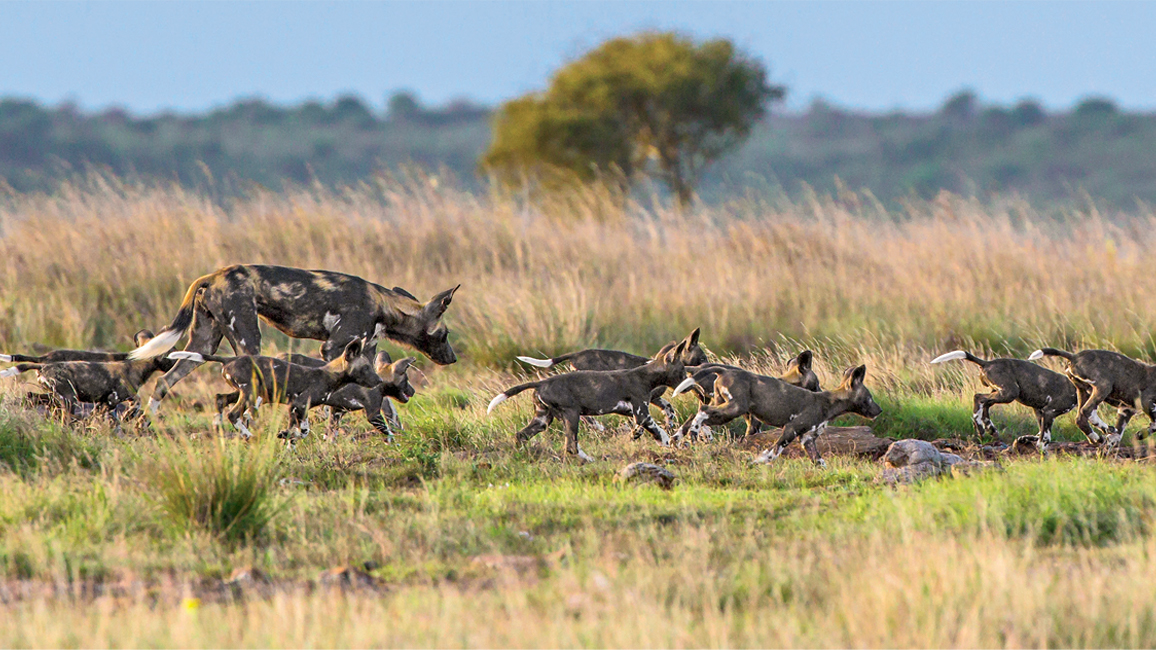
African Wild Dogs
By Ellen LambethIT TAKES A PACK!
Gotta hit the dusty trail—it’s time to HUNT! That’s the “group think” of this pack of African wild dogs on the move (above). After all, the pack’s leaders—Shaka and his mate, Kaya—have tiny new mouths to feed.
Kaya gave birth to Mandisa (top left photo) and her seven siblings in an underground den more than a month ago. Now the pups are old enough to venture out a bit to explore and play. They’re also old enough for Kaya to leave them for a while and join the hunt. But not before she’s sure someone stays behind to watch out for lions, hyenas, and other dangers. That duty might go to an aunt or uncle, or to an older brother or sister. You see, the pack is made up of family members. And they all take turns pitching in.
THE HUNT: A GREAT PACK ATTACK
African wild dogs are excellent hunters. For most predators, the prey gets away far more often than it gets caught. But for a pack of wild dogs, at least one in every three attempts is likely to end in success. The members of Shaka and Kaya’s pack prepare for today’s early-evening hunt. They yip and yap, lick and wag, jump and circle around—doing whatever it takes to get each other fired up and ready to go. Even the pups sense the excitement. Then the adults head out in search of an impala, gazelle, warthog, or any other such prey.
Before long, they set their targets on a warthog. Then it’s all about teamwork. The hunters aren’t big—about the size of border collies. But they’re smart and they’re fast—and each has a crushing bite. By working quickly and closely together, they chase down and surround their prey. Then they close in to make the kill.
The pack meets a couple of gnarly, snarly honey badgers (top photo). But they’re much too much trouble to tussle with. A warthog makes better prey for wild dogs. Above left, pack members team up to take one down and then move in for the meal (above right).
BACK AT THE DEN: IT’S A FAMILY AFFAIR
The kill may seem harsh, but it’s necessary for the pack’s survival. Afterward, the pack’s gentler side shines through. Once the pups become old enough to tag along on a hunt, the adults will give them first dibs on the meal—right on the spot. But for now, the grown dogs scarf down what they can and then head back to the den. There, they deliver pre-chewed meals to Mandisa and the other pups, as well as to any old, sick, or injured pack members. They kept Kaya fed this way, too, when she was stuck at home with her newborns. (Kaya stayed in the den around the clock for the first month of her pups’ lives.) Even now, the entire clan lends a paw to help with the kids. Not only do they babysit and bring food for them, they also help keep them clean, play with them, and teach them the ways of the hunt.
Shaka and Kaya may have been responsible for bringing a new litter into their pack. But it takes the whole pack to raise that litter. Maybe someday Mandisa will find a mate and become the new leader of her own pack.
After the hunt, Mandisa and a brother can hardly wait for their share of the meaty prize! Above left, their uncle barfs up a bit for them and their littermates in front of the den. Afterward, Papa Shaka lovingly gives Mandisa’s messy face a spit shine (above).
Once the day’s chores are all done, several packmates sack out together for a cozy and well-earned snooze (above right).
Rangers: We thank Tico McNutt, director of Botswana Predator Conservation Trust, for his help with this article and for his work to protect wild dogs and other African predators.



















